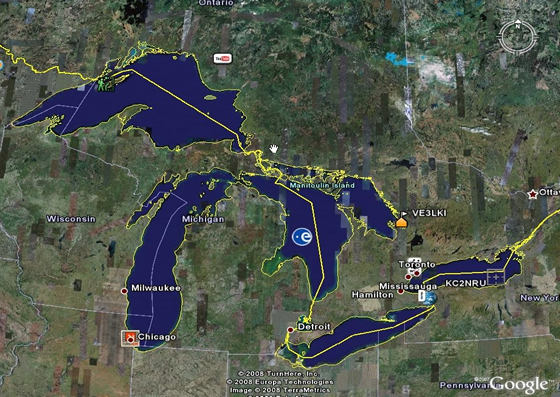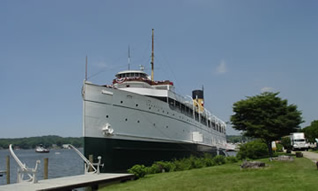Ham Radio Station
RMS Pactor / Robust Packet / Winmor / Relay Operations
Home
| Event Calendar |
| QTH - Location |
| Photos - Users MM's |
| Photos - Users |
| Photos - Lakes |
| Maritime Radio |
| Links |
Radio Station VA3LKI / VE3LKI Location Tucked comfortably away in the Severn Sound Basin of the Georgian Bay |
||
 |
|
|
|
||
The village of Port McNicoll was once the bustling terminus of the CPR rail line from Toronto. At the slip in the village were docked the CPR's finest passenger and cargo ships that sailed the Great Lakes. The docks were decorated in gardens that drew visitors from all parts of Ontario and beyond. When the dark maroon rail coaches stopped at the dockyard, the gardens displayed a welcome for the senses on the one side of the train. On the other side were the gleaming white steamships with glistening brass fittings, portholes and stewards to assist passengers and their luggage from the train to the lounges and cabins on board. Their trip from Port McNicoll to the Lakehead via "the Soo" would take them around 42 hours, allowing for two evenings on board. During the two day journey passengers were treated to all the amenities as was accustomed to the great hotels of their day. Bellhops, waiters, maids and mates were at their disposal. There was a crew of near 90 to take care of the needs of some 280 passengers. Meals always required two sittings in a dining lounge that seated perhaps as many as 140 or so at a sitting. Sixteen waiters took orders from 8 - 10 passengers from a 5 course meal menu. Each course had as many as four options, and the waiters had to remember every individual order without making notes! The wine steward was usually a rather popular fellow. In between meals (as many as 1000 of them prepared by Chinese chefs and cooks), passengers were entertained on deck with games, a cocktail lounge, high tea in the afternoon, and songs and stories in the main lounge and movies in the observation lounge, in the evenings. In addition to the passengers, there was a car deck for as many as 40 vehicles, and cargo decks for freight of all types for delivery to, or forwarding from, the Lakehead. During the times of these ships, the Lakehead ports were known as Fort William and Port Arthur. Built in Scotland at the turn of the 20th century, the vessels (six of them originally) were approximately 360 feet in length, and were sailed across to Canada for service on the Great Lakes. Four of the vessels came to tragic ends and the last two served from the village of Port McNicoll until the late 1960's. The Assiniboia and the Keewatin were always respectfully saluted by the new, larger and faster cargo ships that shared the Lakes with them. Even in port, visitors would come and seek tours about the ships to take in the old world Edwardian luxury of their time.
The Keewatin has returned to Port McNicoll! She arrived home on June 23rd, 2012 - 100 years after her first arrival at the slip where she now rests, enjoying the attention of her volunteer crew and numerous visitors.
|
||
The site administrator reserves all rights and no portion of any pages,
graphics, or data may be reproduced in any manner whatsoever
